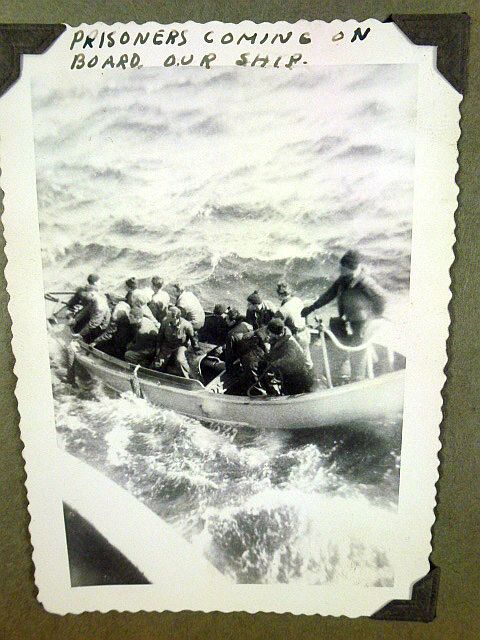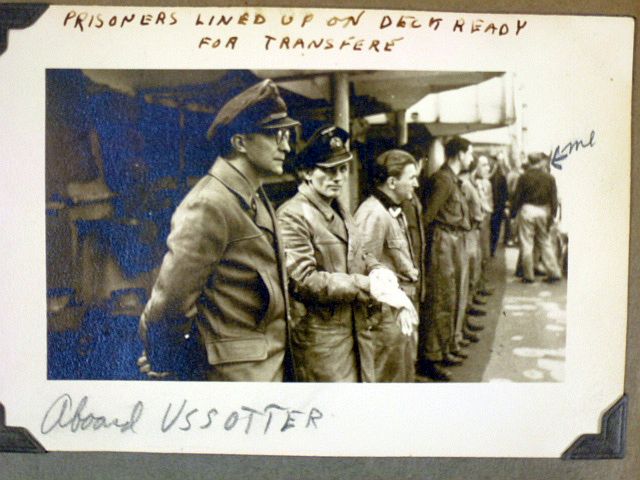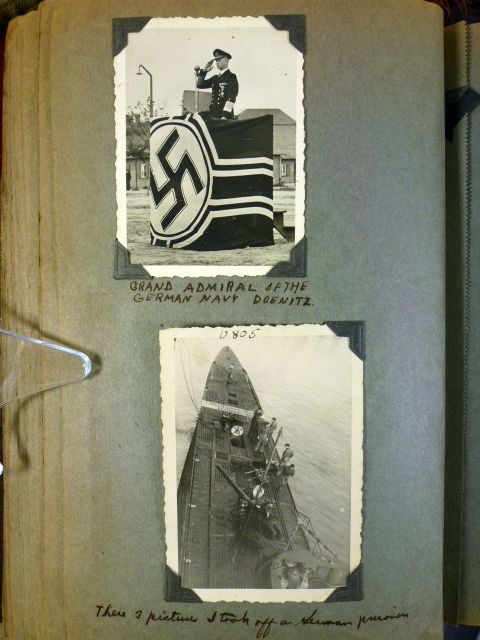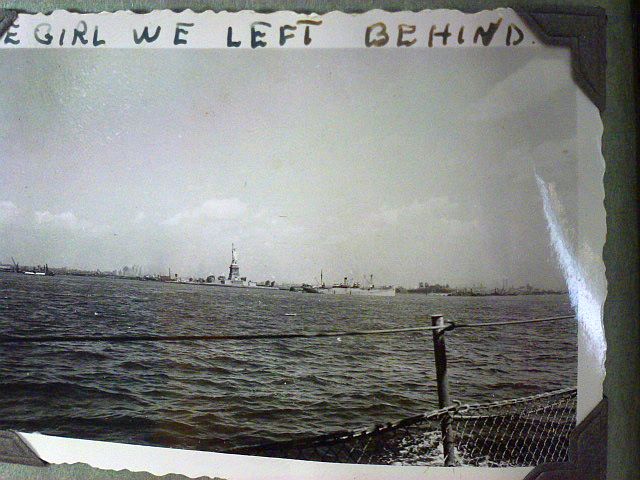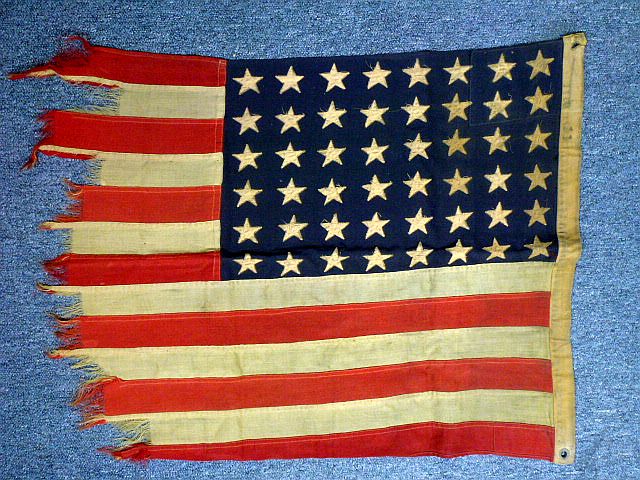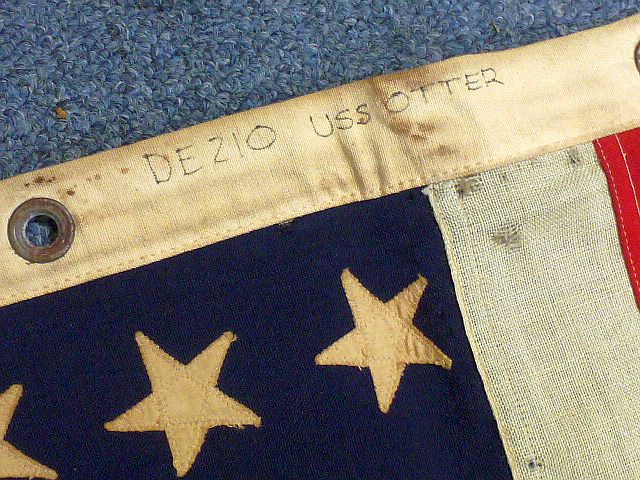USS Otter Photo and Flag Group Part II
These are additional images of the large group of photographs and flags of the World War II destroyer U.S.S. Otter.
The following is the narrative report of the USS Otter setting forth the details of the capture of the German submarine U-805:
U.S. DESTROYERS ATLANTIC FLEET
DESTROYER ESCORT DIVISION SIXTY-TWO
U.S.S. OTTER (DE-210), Flagship
NARRATIVE (Rough transcript of stenographers notes)
THE SURRENDER OF GERMAN SUBMARINE U-805
We arrived at Argentia on the 10th with instructions to expedite fueling and await further orders. Orders were to proceed at good speed and intercept German submarine U-805 which had reported its approximate position in the central northwest Atlantic. Fueling was completed. The party picked out to do the actual boarding was assembled on board one of the ships to facilitate transfer and enable last minute preparations for the known dangerous undertaking of going aboard an enemy submarine. The ships got underway in good order and proceeded in the general direction indicated by instructions. The position of the submarine was so indefinite that the Group Commander decided to break precedent and communicate directly with the submarine in an effort to determine his exact position. This was done and a rendezvous arranged so that the submarine would be met at sunrise on the twelfth.
At sunrise on the twelfth tension was high as the ships approached the point to which the German submarine had been ordered. This tension was in no way relieved by heavy fog which enveloped the entire area. As the navigator informed the Group Commander that his calculations indicated the group was drawing near to the submarine’s position, ships were slowed and crews called to battle stations. Indications on the ship’s radar showed a small ship in the expected position. It was not known whether this was a fisherman or the submarine and it was impossible to determine it without closing to a dangerous range. This later alternative was finally accepted. The ships at battle stations were closed cautiously in until the target became visible at about five hundred yards and was recognized to be the Nazi submarine.
This was the critical point in time for which we had been waiting. It was not known whether the submarine had come there with the expectation of surrendering, of scuttling the ship and abandoning it in hopes of being rescued or of making a “last ditch” fight which under the circumstances would not have been with too great odds against him since at that close range he could easily have torpedoed one of the vessels and probably escaped in the fog.
Through some misunderstanding of the signalman, instead of stopping his engines he did the last thing we wanted him to do and pointed his submarine at us. The captain of the flagship immediately put over hard rudder, went to full speed and maneuvered as radically as he could to avoid any possible torpedo. A number of men instinctively felt to see if their life jackets were securely attached. Just at the point where it was felt that a shot across the bow, or even more aggressive action was called for, he finally understood and stopped his engines. A minute later in carrying out this action, this might have been the story of the last battle of the Atlantic instead of the bringing in of a submarine.
When he complied with this order the tension began to lighten. However, all precautions were still taken to sink the submarine regardless of what he did if he showed any signs of fight or flight.
The boarding party was assembled on the quarterdeck of the flagship and the whaleboat swung out for lowering. The wind was picking up and it was obvious that the time for boarding would be short. Prior to embarking the boarding party the Group Commander came down for last instructions to the Officer-in-Charge. His last instructions were “Do it peaceably if you can, but if necessary be ruthless. Remember if trouble brews my only alternative is to sink the submarine with you aboard.” The radio technician had worked throughout the previous night making a homemade walkey-talkey radio set in order to insure communications with the boarding party.
The boarding party left the ship without a cheer being given but a grim determination settled down over the entire group. Upon receipt of orders to pick up the German submarine the commanding officer of the flagship designated one of his officers to be the Officer-in-Charge of the boarding party. The Officer-in-Charge assembled his men, giving definite instructions and laying out a boarding plan. Twenty picked men were taken from the two ships and two additional officers. Each man and officer was assigned a definite place to go and a definite job to do immediately upon boarding the submarine.
The boarding party entered the whaleboat in high seas and high winds. The tension in the whaleboat when going to the submarine was great. There was no conversation carried on in the whaleboat enroute to the submarine except for radio communication which was kept with the flagship by an officer appointed by the Officer-in-Charge of the boarding party.
Upon boarding the submarine the Officer-in-Charge immediately sent a signalman to cut down the black surrender flag and put up the American ensign. The Chief Machinist’s Mate immediately went to the conning tower and dropped a heavy chain through the hatches and locked this chain at the conning tower to prevent any possibility of closing hatches and diving the submarine.
The Officer-in-Charge informed the commanding officer of the submarine that, “You, your officers and men are prisoners of war and the ship is the property of the United States Government. I am assuming command upon verbal orders of the Group Commander”. The former commanding officer was informed that the Officer-in-Charge intended to search the submarine, that he should go with him and that any resistance from the men or any attempted sabotage would result in the men being immediately shot.
All prisoners of war were required to stand with their arms folded. The former commanding officer was sent below, the Officer-in-Charge following him down. All men of the boarding party then immediately went below to their assigned stations. A search was started throughout the ship for demolition bombs and booby traps. The Officer-in-Charge was assisted in this search by a gunner’s mate who had formerly boarded 21 German submarines in Brest, France, in demolition work.
Forty minutes after the arrival of the first boat the Assistant Officer-in-Charge arrived aboard with the rest of the boarding party. These men went immediately below to help complete the search of the ship.
The ship was thoroughly searched and no demolition equipment or booby traps were found aboard. The German captain had jettisoned all of his ammunition, the breeches from all guns and the detonators and boosters from all torpedo tubes and all small arms over the side prior to our arrival aboard. The boarding party took three hours shaking down the ship looking for demolition equipment, knives, guns or anything that could be used as a weapon or as means to sabotage the ship enroute to the United States. There were approximately 20 to 30 sheath knives and pocket knives found on the men and in their lockers. Many of the prisoners had pictures of their homes and pictures of their families.
The Officer-in-Charge made an inspection of all German prisoners and any men who looked the least bit out of line or was thought might make trouble was sent to the flagship under guard. A total of 11 enlisted ratings and two officers were sent to the flagship. Upon being brought aboard the flagship they were sent directly to washrooms to be cleaned up and disinfected. All clothing was confiscated for sterilization and laundering and Red Cross survivor’s kits, less razors, were issued to each man. One living compartment had been vacated by the ship’s force and the prisoners were then directed to this space. The two officers were confined in the Chief Petty Officer’s wardroom.
Upon completion of the search of the ship and sending the few prisoners from the ship, preparations were immediately made to get underway. Upon getting underway all prisoners were allowed to unfold their arms and be at ease on the ship. The prisoners were all berthed in the forward torpedo room. The after torpedo room was taken over for quarters for the boarding party.
The German prisoners were used on watch in the engine room, the motor room, control room and helm under the supervision of the boarding party, each of whom was armed with Thompson sub-machine guns. Upon getting underway soundings were taken of all fuel tanks, water tanks and ballast tanks. An estimate of the fuel aboard was taken and the speed that could be made back to the States. A speed was set at 14 knots to return to the States.
The radio room was used for stowing of arms when the men were not on watch and additional material that would be of interest. No man was allowed in this radio room except the watch and to draw guns the men had to open a small inspection port an d be identified. The radiomen on watch stood his watch with the radio key by one hand and a 45 pistol by the other with orders to shoot any man entering the radio room.
Upon completion of preparations for getting underway, the Group Commander was informed the boarding party was ready to get underway. Information was received that the submarine was capable of making any reasonable speed and could make about 1200 to 1500 miles on the fuel which she had aboard. It was decided to proceed at 12 knots in order to reach the Eastern Sea Frontier’s surrender point at about daylight. Solid sheets of water completely enveloped the bridge of the submarine and watch standing was very hazardous, with radio communication with the other two ships almost impossible. At times the submarine was completely obscured from the view of the flagship. One escort stationed on either beam of the submarine close enough to keep it under constant watch. According to a pre-arranged plan some communication was sent every half hour from the party on board to the escorts in order that they could know everything was under control. During this thirty minute authentication with the flagship many fellows had a chance to get in sharp point of view their shipmates aboard the flagship. From the Group Commander’s point of view the remainder of the trip, except for dodging a few fishermen here and there, was uneventful until the arrival at the pre-arranged point where boats with photographers became a real hazard.
The prisoners wanted to know if the boarding party was going to stay on board the submarine with them and so to the Pacific to fight the Japs.
The First Officer had learned English at school and after a few hours a fair conversation could be carried on with him concerning the operation and running of the ship. One of the first questions asked by the First Officer was who was the new president. He also asked if Tom Mix was king of the movies and whether the gangster problem was still tough in Chicago. He showed an amazing knowledge of all east coast ports and their facilities.
The prisoners were very cooperative with the boarding party and gave them much general information concerning the ship, its diving power, the time it took to dive, the depth it could dive, the time they could stay submerged and the ship’s speed. They took great pride in their ability to torpedo ships. They showed the boarding party the procedure they would go through in torpedoing ships while surfaced or submerged. There were 14 torpedoes aboard of which six were in the torpedo tubes. Weather conditions were so bad that torpedoes could not be removed from the tubes. The inside torpedo doors were opened and locked in that position. Schnorkel equipment, manual control for diving, control valves for main ballast tank were chained and locked shut.
Upon inspection of their radio shack and communication office we found everything to be amazingly intact, which appeared rather strange. Their coding machines and code books were all in their proper place and the radio transmitting and receiving gear were all intact with the exception of their underwater receiving set. Their radio gear was very simple but proved very effective in carrying on communication between ships. They had a public address system over which they played American popular records and the “Hit Parade” of Germany. The navigation gear was undamaged and revealed some navigation instruments for which we have no comparison in the U.S. Navy. The sextants and binoculars seemed far superior to ours. The communication inspection was made by an officer appointed by the Officer-in-Charge of the boarding party.
The submarine had on board 900 liters of drinking water and had facilities for making 200 to 250 liters per day. They claimed they had been at sea for eight weeks and after 12 hours underway claimed they had been on the surface longer in that time than in the eight weeks since they left port. The only place to take a shower was a cold salt water shower.
The only English the prisoners knew was, “Good morning, Sir”, and how to salute an officer. When an officer made a trip through the submarine all the prisoners would immediately come to attention of their own accord. Prisoners in going from watch to the forward torpedo room in coming through the wardroom would come to attention and ask for permission to pass through the wardroom. It is estimated that all men of the boarding party in the three days bringing the ship to the United States got an average of two to three hours sleep, during that time.

